- Home
- About
- Map
- Trips
- Bringing Boat West
- Migration West
- Solo Motorcycle Ride
- Final Family XC Trip
- Colorado Rockies
- Graduates' XC Trip
- Yosemite & Nevada
- Colorado & Utah
- Best of Utah
- Southern Loop
- Pacific Northwest
- Northern Loop
- Los Angeles to NYC
- East Coast Trips
- 1 Week in Quebec
- Southeast Coast
- NH Backpacking
- Martha's Vineyard
- Canadian Maritimes
- Ocracoke Island
- Edisto Island
- First Landing '02
- Hunting Island '02
- Stowe in Winter
- Hunting Island '01
- Lake Placid
- Chesapeake
- Provincetown
- Hunting Island '00
- Acadia in Winter
- Boston Suburbs
- Niagara Falls
- First Landing '99
- Cape Hatteras
- West Coast Trips
- Maui
- Mojave 4WD Course
- Colorado River Rafting
- Bishop & Death Valley
- Kauai
- Yosemite Fall
- Utah Off-Road
- Lost Coast
- Yosemite Valley
- Arizona and New Mexico
- Pescadero & Capitola
- Bishop & Death Valley
- San Diego, Anza Borrego, Joshua Tree
- Carmel
- Death Valley in Fall
- Yosemite in the Fall
- Pacific Northwest
- Utah Off-Roading
- Southern CA Deserts
- Yosemite & Covid
- Lake Powell Covid
- Eastern Sierra & Covid
- Bishop & Death Valley
- Central & SE Oregon
- Mojave Road
- Eastern Sierra
- Trinity Alps
- Tuolumne Meadows
- Lake Powell Boating
- Eastern Sierra
- Yosemite Winter
- Hawaii
- 4WD Eastern Sierra
- 4WD Death Valley +
- Southern CA Deserts
- Christmas in Tahoe
- Yosemite & Pinnacles
- Totality
- Yosemite & Sierra
- Yosemite Christmas
- Yosemite, San Diego
- Yosemite & North CA
- Seattle to Sierra
- Southwest Deserts
- Yosemite & Sierra
- Pacific Northwest
- Yosemite & South CA
- Pacific Northwest
- Northern California
- Southern Alaska
- Vancouver Island
- International Trips
- Index
- Tips
- Books
- Photos/Videos
- Search
- Contact
Barcelona, Spain
Sunday, May 19, 2019 - 1:30pm by Lolo
0 miles and 0 hours from our last stop - 4 night stay
Travelogue
 Arc de Triomf de BarcelonaIt didn’t take us too long during our trip planning to pick Barcelona as our base city before venturing out in our camper van to tour the country. We decided that we would stay four nights as that would give us three full days to cover a lot of ground.
Arc de Triomf de BarcelonaIt didn’t take us too long during our trip planning to pick Barcelona as our base city before venturing out in our camper van to tour the country. We decided that we would stay four nights as that would give us three full days to cover a lot of ground.
Location, location, location is the most important criteria we consider in selecting a hotel, without paying too much, so it was a pretty easy choice to book our stay at Motel One located across the street from the lovely Parc de la Ciutadella, and in easy walking distance to the Gothic Quarter and Las Ramblas.
We landed in Barcelona 4:45 in the afternoon after a 13 hour direct flight from San Francisco. From the airport it was an easy transport on the Aerobus shuttle to the Placa de Catalunya, which was less than a mile from our hotel. Somewhat foolishly, rather than call a cab, we decided to walk it, which wouldn’t have been too bad if we had had some sleep in the last 24 hours and didn’t have our luggage to carry -- although I must say that our luggage wasn’t as bad as it could have been if Herb hadn’t restricted me to one carry-on bag.
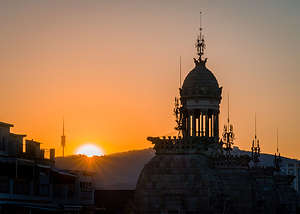 View from Motel One rooftop barWe were quite pleased when we arrived at our hotel. We already knew that the location was great, but the atmosphere of the hotel was awesome as well - beautiful, bright lobby, nice big dining room where a breakfast buffet is served every morning, rooftop bar overlooking the city, and a comfy (yet a bit small) room. Plus, the price was right considering its excellent location - about 130 € per night.
View from Motel One rooftop barWe were quite pleased when we arrived at our hotel. We already knew that the location was great, but the atmosphere of the hotel was awesome as well - beautiful, bright lobby, nice big dining room where a breakfast buffet is served every morning, rooftop bar overlooking the city, and a comfy (yet a bit small) room. Plus, the price was right considering its excellent location - about 130 € per night.
We were pretty exhausted, so we took a quick nap, but not too long because we wanted to be able to fall asleep at Spain bedtime (which actually is like 3:00 am) and get in synch with the local time as soon as possible.
Herb looked at Trip Advisor and found a highly rated pizza place called La Mezcla, less than a half a mile from our hotel.
It was the perfect choice for two tired old tourists on their first night in Barcelona.
Day 1 - Las Ramblas, Gothic Quarter, Barceloneta, and Montjuic
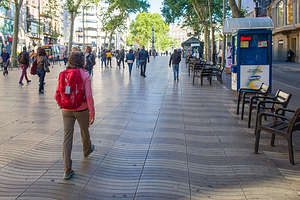 Lolo strolling along the wavy tile work of Las RamblasWe both slept quite well considering it was our first night and were ready for a big day touring the city. I kiddingly said we should walk 20 miles today, words I would later regret.
Lolo strolling along the wavy tile work of Las RamblasWe both slept quite well considering it was our first night and were ready for a big day touring the city. I kiddingly said we should walk 20 miles today, words I would later regret.
When we booked our room, we did not opt for the breakfast, which was an extra 9 € per person. However, when we saw the spread laid out, we changed our mind. There was fruit, eggs, Muesli, breads, cheeses, jamon (of course), croissants filled with various goodies including chocolate, and on and on. Herb easily ate 30 € worth.
We definitely needed to walk that off, so off we went, starting our day with a stroll along Las Ramblas, Barcelona’s most famous pedestrian mall. It begins at the Placa de Catalunya (where we arrived from the airport yesterday) and ends at the waterfront, a little over a mile away.
It used to be a place where locals hung out, but unfortunately, it has now been taken over by tacky souvenir shops, so-so restaurants, pickpockets (mostly at night), and hordes of tourists, stripping it of much of its charm. Still, it is a very nice walk, especially in the morning when it is quieter, with many interesting sights along the way, such as:
- Fountain of Canaletes - ornate black and gold lamp post with a fountain at its base. Legend says that a drink from it ensures you will return to Barcelona one day
- Wavy tile work - represents the stream that once flowed here
- Chairs fixed to the sidewalk at jaunty angles
- Betlem Church - 17th century Baroque church with sloping roofline, ball-topped pinnacles, corkscrew columns
- Rambla of Flowers - flower stands
- La Boqueria Market - Barcelona’s iconic produce market, with a maze of stalls selling fruits and veggies, fish and seafood, meats and mushrooms, and spices and candy
- Plaça de la Boqueria - here you will see the Joan Miro mosaic in red, white, yellow, and blue
- Plaça Reial - dotted with palm trees and surrounded by yellow buildings with white trim this placa has old-fashioned taverns as well as modern bars with patio seating
- Palau Guell - apartment building designed by Antoni Gaudi. This was the first of his Modernista buildings, and you can see his emerging nonlinear style in the arches and doorways
- Christopher Columbus monument
- Rambla del Mar - wavy wooden walkway along the waterfront
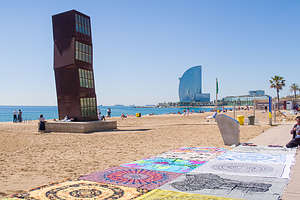 La Estrella Herida and vendor wares along Barceloneta BeachOnce we got to the waterfront, we headed north along the city’s lovely man-made beach, which extends for several miles, with many seafood restaurants and bars along the way.
La Estrella Herida and vendor wares along Barceloneta BeachOnce we got to the waterfront, we headed north along the city’s lovely man-made beach, which extends for several miles, with many seafood restaurants and bars along the way.
Despite the signs warning no street vendors allowed, the entire promenade was lined with people selling their wares. I loved watching them meticulously, and obviously with a great deal of pride, set up their items in the most appealing manner possible. For example, those selling shoes placed one shoe down, and the other on a diagonal across the first. And they did this for 30+ pairs of shoes.
The item I was most tempted to buy was one of the large beach blankets with intricate patterns on it. Some looked like oriental rugs. Others had elephants (like the kind you find on Thai elephant pants). However, by allowing me only a carry-on bag, Herb had pretty much cut off any possibility of shopping, as my bag could not even have fit another pair of underwear in it. Very clever of him.
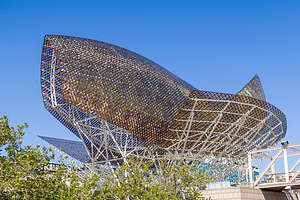 Frank Gehry's Peix (Fish)Of course, you can’t go too far in Barcelona without encountering contemporary art, so it wasn’t long before we came upon La Estrella Herida, a 33-foot beach sculpture of four stacked leaning steel cubes, with windows, by the artist Rebecca Horn.
Frank Gehry's Peix (Fish)Of course, you can’t go too far in Barcelona without encountering contemporary art, so it wasn’t long before we came upon La Estrella Herida, a 33-foot beach sculpture of four stacked leaning steel cubes, with windows, by the artist Rebecca Horn.
Continuing our beach promenade, in less than a mile we met Frank Gehry’s Peix, a 56 meter long and 35 meter high golden fish, built for the 1992 Barcelona Olympics. It’s constructed of intertwining gilded golden steel strips and is held together by a metal structure. Its shiny gold surface, which gives the appearance of fish scales, changes appearance depending on the weather and the angle of the sun.
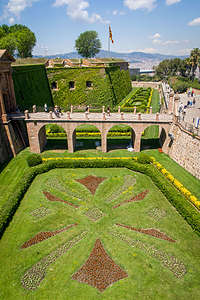 Montjuic CastleAfter the fish, we turned around and retraced our steps along the Barceloneta with the intention of taking the cable car up to Montjuic. During the entire walk south along the Barceloneta, the famous W Hotel loomed over the beach. Even the hotels in Barcelona are artistic masterpieces. This one, which was designed by Ricardo Bofill, is in the shape of a sail, very appropriate for its location on the sea. It’s huge, and I am sure much more expensive than our humble abode at Motel One.
Montjuic CastleAfter the fish, we turned around and retraced our steps along the Barceloneta with the intention of taking the cable car up to Montjuic. During the entire walk south along the Barceloneta, the famous W Hotel loomed over the beach. Even the hotels in Barcelona are artistic masterpieces. This one, which was designed by Ricardo Bofill, is in the shape of a sail, very appropriate for its location on the sea. It’s huge, and I am sure much more expensive than our humble abode at Motel One.
We continued on to Transbordador Aeri del Port, where we had planned to be whisked in style to the top of Montjuic. However, the line was long and about an hour wait, so we decided to just walk to the top instead. After all, it was only 3 miles. What we didn’t factor in was that it was mostly uphill, it was hot, and we were hungry, and there were no restaurants along our route. I confess to getting a wee bit cranky.
Halfway up the mountain, we stopped on a bench near a fancy hotel, so I could whine for a bit and eat a Cliff Bar that I found at the bottom of my pack. Why wasn’t Herb suffering as much as me, which made me even crankier.
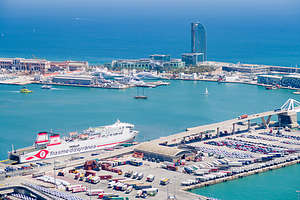 View of the Port of Barcelona from MontjuicFinally, we got to the Montjuic Castle on top, which did have great views of the city and the port. We also went inside for a tour where we learned that this 17th century fortress has had rather a dark history of being used as a political prison and killing ground. Well, that was a real mood picker upper.
View of the Port of Barcelona from MontjuicFinally, we got to the Montjuic Castle on top, which did have great views of the city and the port. We also went inside for a tour where we learned that this 17th century fortress has had rather a dark history of being used as a political prison and killing ground. Well, that was a real mood picker upper.
We walked back down the mountain towards our hotel, but I wasn’t done yet. I still wanted to see the Gothic Quarter, which we had to walk through anyway to get back home.
I had Herb key in a few key stops on my list of things to see there, but with the narrow alleyways, our GPS just wasn’t working. We couldn’t even find the Barcelona Cathedral. In retrospect, it would have been much better to have had a physical map, because Google Maps won’t help you when satellites are blocked. It was very frustrating.
We decided to go back to the hotel for a nap and then go out again for another go at the historic Gothic quarter, where Rick Steves suggested we should lose ourselves along its old Medieval cobblestone lanes. I had written down some interesting things that he suggested seeing.
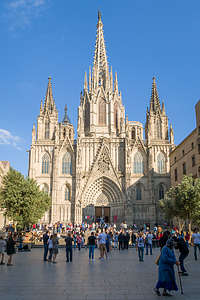 Barcelona CathedralOne of the main things I wanted to do was to see the Barcelona Cathedral. Just to make sure, I checked the website to confirm that entry for tourists was until 7:15, as worship services started at 7:45.
Barcelona CathedralOne of the main things I wanted to do was to see the Barcelona Cathedral. Just to make sure, I checked the website to confirm that entry for tourists was until 7:15, as worship services started at 7:45.
We found it quite easily this time - not sure how we missed it before, but when we approached the church to enter it at 6:45, we were turned away and I have no idea why as the explanation was in Basque. Still, the exterior of the church is absolutely breathtaking, so we satisfied ourselves with that. It was built in the 14th century in the Gothic Flamboyant (“flame-like”), style, characterized by pointed arches and spires, and stained glass windows elaborate “flame-like” tracery.
Herb had been much more fortunate on a visit here over 30 years ago, as he got to see Barceloneans joining together for a Sardana dance, where they link hands and dance in a circle. This dance is performed on Sundays at 11:15 and many Saturdays at 18:00.
Adjacent to the Cathedral is the Casa del Ardiaca , an old mansion that now functions as the city archives. From the courtyard, we climbed up to the balcony for views of the Barcelona Cathedral steeple and gargoyles.
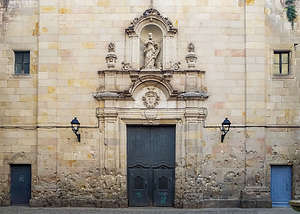 Shrapnel wounds from the Spanish Civil War in the Placa Sant Felip NeriWe continued wandering through the Gothic quarter and eventually stumbled upon the tiny Placa Sant Felip Neri, a small shaded square with a fountain in its center, which is now the playground of an elementary school. However, this place was not always so delightful a place to be. During the Spanish Civil War, in 1938 Franco’s fascists bombarded this area, killing 42 people, mostly children. You can still see the shrapnel wounds in the facade of the old Baroque church, a haunting reminder of this Spain’s horrific past.
Shrapnel wounds from the Spanish Civil War in the Placa Sant Felip NeriWe continued wandering through the Gothic quarter and eventually stumbled upon the tiny Placa Sant Felip Neri, a small shaded square with a fountain in its center, which is now the playground of an elementary school. However, this place was not always so delightful a place to be. During the Spanish Civil War, in 1938 Franco’s fascists bombarded this area, killing 42 people, mostly children. You can still see the shrapnel wounds in the facade of the old Baroque church, a haunting reminder of this Spain’s horrific past.
Although infinitely more peaceful than during the horror of the Civil War, there is still much political unrest in Barcelona, as the Catalonians continue to seek their independence from the rest of Spain. “Free are political prisoners” is painted on many walls throughout the city and the Catalonian separatist flag, La Estelada hangs from many a balcony. So, history forges on.
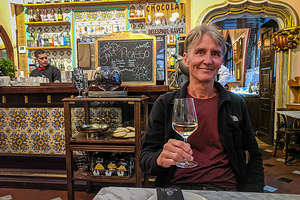 Dinner at Els Quatre Gats, Picasso's old hangoutIn addition to being able to take a journey through Barelona’s Medieval and Spanish Civil War past, there are also Roman ruins dating back to when the Romans founded the town of Barcino in 12 BC. The Playa Nova is flanked by two Roman towers that once guarded the entrance to the city and there are ruins of an ancient Roman Temple of Augustus. Unfortunately, it was closed for restoration.
Dinner at Els Quatre Gats, Picasso's old hangoutIn addition to being able to take a journey through Barelona’s Medieval and Spanish Civil War past, there are also Roman ruins dating back to when the Romans founded the town of Barcino in 12 BC. The Playa Nova is flanked by two Roman towers that once guarded the entrance to the city and there are ruins of an ancient Roman Temple of Augustus. Unfortunately, it was closed for restoration.
Amazing how we strolled through millenniums of history in such a small distance.
We ended our very full day with dinner at Els Quatre Gats (or Esl 4Gats), a circe 1900 cafe and restaurant that was once a popular hangout for Picasso and other Modernista artists. It was quite cozy. We sat in the bar section having tapas (salt cod, bravas, mozzarella and sauce) and wine, and talking about all that we had seen that day in our 20 miles of walking around this wonderful city.
Day 2 - Full Gaudi Day
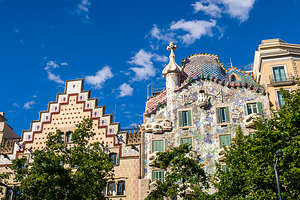 Rooftop of Gaudi's Casa BatlloHappy Gaudi Day! Today, was going to be another full day of walking and exploring, with our goal of seeing as many examples of Gaudi’s works as possible, and, believe me, there are many in Barcelona.
Rooftop of Gaudi's Casa BatlloHappy Gaudi Day! Today, was going to be another full day of walking and exploring, with our goal of seeing as many examples of Gaudi’s works as possible, and, believe me, there are many in Barcelona.
Gaudi and the soccer player Messi are probably the two most popular and well-known names in Barcelona, and rightly so, as they both have done so much to draw attention to this wonderful city.
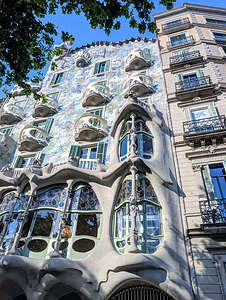 Gaudi's Casa Batllo on the Block of DiscordHowever, Gaudi’s skills were of a different sort. Born in 1852, he studied architecture in Barcelona and went on to a long distinguished career building a number of innovative works throughout the city. He is considered to be the master of Catalan Modernism, a style characterized by asymmetry, the predominance of wavy curves over straight lines, the use of vegetal and other organic motifs, intricate decoration and detail, and brightly colored glass and tile - elements not commonly used in architecture up to this time.
Gaudi's Casa Batllo on the Block of DiscordHowever, Gaudi’s skills were of a different sort. Born in 1852, he studied architecture in Barcelona and went on to a long distinguished career building a number of innovative works throughout the city. He is considered to be the master of Catalan Modernism, a style characterized by asymmetry, the predominance of wavy curves over straight lines, the use of vegetal and other organic motifs, intricate decoration and detail, and brightly colored glass and tile - elements not commonly used in architecture up to this time.
We began our exploration in the Eixample, a neighborhood of Barcelona just beyond the Old City that was at the heart of the Modernista movement. At the center of this neighborhood is the Block of Discord (Passeig de Gràcia), where we saw two of Gaudi’s colorful Modernista works.
The first was the Casa Batllo, one of the largest residential buildings in Europe, located on Passeig de Gracia, 43. It is one of Gaudi’s most famous and photographed works. Although he didn’t actually build it, he did do extensive renovations to it in the early 1900s, which brought it to its current innovative form.
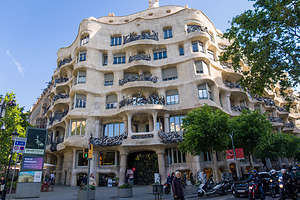 Gaudi's Casa Mila (La Predera)The exterior of the building is sprinkled with bits of blue, mauve, and green mosaic tiles and studded with wave-shaped window frames and protruding balconies. There wasn’t a straight line to be found. The rooftop resembles the back of a dragon and has four colorful chimneys.
Gaudi's Casa Mila (La Predera)The exterior of the building is sprinkled with bits of blue, mauve, and green mosaic tiles and studded with wave-shaped window frames and protruding balconies. There wasn’t a straight line to be found. The rooftop resembles the back of a dragon and has four colorful chimneys.
We didn’t get to see the interior of Casa Battlo, because it is currently undergoing renovations. They still do allow visitors, but since we couldn’t see everything, we chose instead to buy tickets to enter La Pedrera (Casa Mila), one of Gaudi’s trademark works and a Modernisme icon. It is located at Passeig de Gràcia, 92. It is very popular, so it’s a good idea to buy a timed-entry ticket in advance: http://www.lapedrera.com/es/prepara-la-visita/tarifas
The building was commissioned in 1906 by the wealthy industrialist Pere Mila i Camps. That is why it is sometimes called Casa Mila. However, its official name is La Pedrera, which means “stone quarry,” because of its rocky, jagged facade. La Pedrera was actually a pejorative name given to it by the wealthy neighbors who thought it looked like a dirty and ugly stone quarry. Well, they got that one wrong.
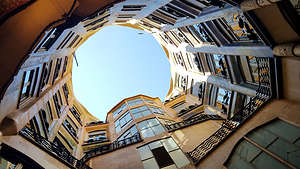 Atrium of Gaudi's Casa MilaSince we had tickets, we got online for our 9:30 timed entry. The building is considered to be the purest of Gaudi’s interiors and to have been designed at the height of his abilities. It was also the last civil engineering project he would undertake in his career. Most of the rest of his life would be spent on his religious devotion and the building of the amazing Sagrada Familia, which we will get to later.
Atrium of Gaudi's Casa MilaSince we had tickets, we got online for our 9:30 timed entry. The building is considered to be the purest of Gaudi’s interiors and to have been designed at the height of his abilities. It was also the last civil engineering project he would undertake in his career. Most of the rest of his life would be spent on his religious devotion and the building of the amazing Sagrada Familia, which we will get to later.
Our first stop in the building was a large open-to-the-sky courtyard, 16 floors high. This was very innovative for its time. Not only was it aesthetically beautiful, but it served the function of improving the lighting and ventilation on all 16 apartments (there was one apartment per floor).
We got to see a replica of one of those apartments. Wow! What it must have been like to live in this elegant and unique building. There was so much natural light flooding in from the courtyard into each of the rooms that circled it. Gaudí actually designed some of the decorative elements, such as the mouldings, door knobs, and flooring.
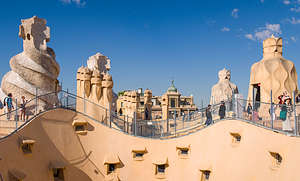 Rooftop of Gaudi's Casa MilaHowever, by far my favorite part of the tour was the bizarre rooftop, covered with weirdly shaped chimneys, reminiscent of Star Wars figures, and rightly so, as it was these chimneys that inspired George Lucus’ stormtroopers’ masks. There are 36 chimneys in total, some of them decorated with mosaic, stones, marble, and glass. The 6 largest ones have staircases inside and 2 of them are ventilation shafts - always coming form and function.
Rooftop of Gaudi's Casa MilaHowever, by far my favorite part of the tour was the bizarre rooftop, covered with weirdly shaped chimneys, reminiscent of Star Wars figures, and rightly so, as it was these chimneys that inspired George Lucus’ stormtroopers’ masks. There are 36 chimneys in total, some of them decorated with mosaic, stones, marble, and glass. The 6 largest ones have staircases inside and 2 of them are ventilation shafts - always coming form and function.
Since Gaudi did not like straight lines, even the floor of the roof was uneven so we had to watch our step. We spent a good deal of time up there enjoying both the chimneys as well as the panoramic view over Barcelona. We could even see the Sagrada Familia!
Next stop on the Gaudi Tour - Park Guell, a public park designed by Gaudi, located atop Carmel hill, just a little over a mile and a half way.
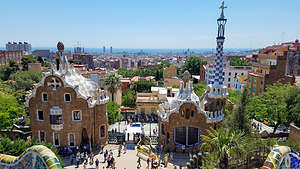 Park Guell's monument zoneMost of the park is free, except for the very popular Monumental Zone, where most of Gauid’s iconic creations are. Only 400 visitors are allowed in each hour, so it’s a good idea to buy a timed-entry ticket in advance: https://parkguell.barcelona/en/planning-your-visit/prices-and-times
Park Guell's monument zoneMost of the park is free, except for the very popular Monumental Zone, where most of Gauid’s iconic creations are. Only 400 visitors are allowed in each hour, so it’s a good idea to buy a timed-entry ticket in advance: https://parkguell.barcelona/en/planning-your-visit/prices-and-times
We had some time to kill before our 1:00 entry, so we wandered around the free part of the park for awhile, before lining up like cattle with the other 398 lucky ticket holders to enter the Monumental Zone.
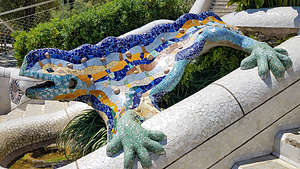 Park Guell's monument zoneThe Zone made me feel a bit like I had entered the board game Candyland or some other bizarre fanciful land. There are two Hansel and Gretel gatehouses, a multicolored mosaic lizard named “El Drac” guarding a whimsical staircase, long serpentine wavy benches, and a panoramic view terrace supported by a forest of columns. It was pretty whimsical.
Park Guell's monument zoneThe Zone made me feel a bit like I had entered the board game Candyland or some other bizarre fanciful land. There are two Hansel and Gretel gatehouses, a multicolored mosaic lizard named “El Drac” guarding a whimsical staircase, long serpentine wavy benches, and a panoramic view terrace supported by a forest of columns. It was pretty whimsical.
The original intention of Guell was to build 60 single-family homes here, but that didn’t work out, and the project was stopped. In 1923 the park became city property, and in 1926 it opened as a public park. it was listed as a UNESCO World Heritage Site in 1984.
One of the model houses was bought by Gaudi, and he lived in it from 1906 to 1925. You can visit the interior of this home, but the line was much too long, so we decided to move on to our final stop on our Gaudi tour - the Sagrada Familia, for which we had 3:45 entry tickets.
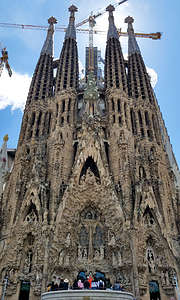 Gaudi's Sagrada FamiliaThe Sagrada Familia is Antoni Gaudi’s magnum opus, a creation so incredibly beautiful and innovative that it must be experienced in person to truly appreciate. Words cannot do it justice. You simply must see it for yourself.
Gaudi's Sagrada FamiliaThe Sagrada Familia is Antoni Gaudi’s magnum opus, a creation so incredibly beautiful and innovative that it must be experienced in person to truly appreciate. Words cannot do it justice. You simply must see it for yourself.
But first some logistics:
The church is open to the public, but since it is the second most visited site in Spain (the Alhambra in Grenada is the first), you really have to buy timed-entry tickets well in advance: http://www.sagradafamilia.org/en/. I highly recommend getting the audio guide or taking a guided tour as there is so much so see and learn in this massive church.
If you are interested in visiting the towers, note that these require a special ticket as tower access is not included in the main tickets. You can book a tower entrance ticket along with your main ticket on the same website.
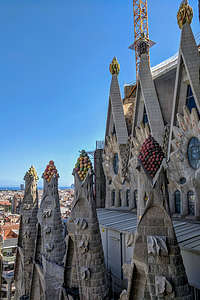 View outside the windows of the Nativity TowerWhen purchasing our tickets, several months before leaving, we agonized for some time over what time of day was best to go, and which, if any, tower to go up. We chose the Nativity Tower because that was the only one completed during Gaudi’s lifetime, so it was purely his work. As far as the timing, the consensus seemed to be that the light streaming through the beautiful stained glass windows was most heavenly between 5 and 6 pm. Although, there were plenty of people suggesting other times of day would be preferable for photographing the exterior. Personally, I think any time of day would be incredible. Anyway, we purchased tickets for a 3:45 entry (with audio guide), where we could have access to the Nativity Tower at 4:00. That way we could just hang out in the basilica afterwards and photograph the interior for as long as we wanted.
View outside the windows of the Nativity TowerWhen purchasing our tickets, several months before leaving, we agonized for some time over what time of day was best to go, and which, if any, tower to go up. We chose the Nativity Tower because that was the only one completed during Gaudi’s lifetime, so it was purely his work. As far as the timing, the consensus seemed to be that the light streaming through the beautiful stained glass windows was most heavenly between 5 and 6 pm. Although, there were plenty of people suggesting other times of day would be preferable for photographing the exterior. Personally, I think any time of day would be incredible. Anyway, we purchased tickets for a 3:45 entry (with audio guide), where we could have access to the Nativity Tower at 4:00. That way we could just hang out in the basilica afterwards and photograph the interior for as long as we wanted.
A little background:
Gaudi did not do the initial plans for this church, nor was he its first architect. However, when the first architect, Francisco Paula de Vilar, resigned in 1882, Gaudi took over the project and made radical changes to the original plans. To say that his design was unconventional is a gross understatement, but we had seen enough of Gaudi’s works today to expect nothing less.
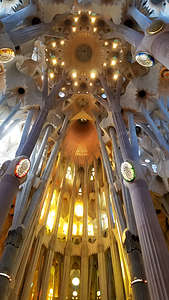 Interior of the Sagrada FamiliaGaudi was only 31 when he took over the project, and he continued in that role for 43 years until his tragic death in 1926, when he was hit and killed by a trolley car on his way to confession. From 1914 until his death he abandoned all other projects and completely devoted himself to this church, even moving into the workshop on site.
Interior of the Sagrada FamiliaGaudi was only 31 when he took over the project, and he continued in that role for 43 years until his tragic death in 1926, when he was hit and killed by a trolley car on his way to confession. From 1914 until his death he abandoned all other projects and completely devoted himself to this church, even moving into the workshop on site.
At the time of his death, less than 25% of the church was complete. However, he knew he would never live to see the basilica completed, so he left his vision of the building for future architects in the form of models and sketches. Construction of the church is still in progress -- hence all the cranes and scaffolding - and is expected to be finished in 2026 (a century after his death).
The building, which is a combination of Gothic, Catalan Modernism, and Art Nouveau styles, combines all of the elements that Gaudí used and experimented with in his earlier works - the predominance of wavy curves over straight lines, parabolas instead of circles, the use of vegetal and other organic motifs, intricate decoration and detail, and brightly colored glass and mosaics.
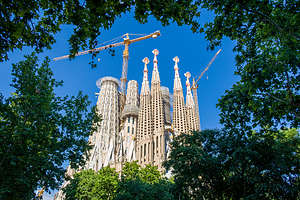 One last view of the Sagrada FamiliaThe exterior:
One last view of the Sagrada FamiliaThe exterior:
Currently there are eight 330-foot spires topped with crosses. When the church is completed there will be 18: 12 representing the apostles, (over the three entrances), 4 taller ones representing the evangelists, an even higher one designated for the Virgin Mary, and the final 18th one, which will be the highest one in the middle, representing Jesus Christ.
There are three facades, each depicting a phase in the life of Jesus: nativity, passion, and glory. Only the Nativity Facade was completed during Gaudi’s lifetime. The Passion Facade was completed in 2006, and the Glory Facade is still under construction.
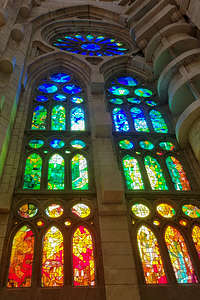 Sagrada Familia stained glass windowsThe interior:
Sagrada Familia stained glass windowsThe interior:
Like most basilicas, the Sagrada Família has a cruciform (Latin cross) plan, with a five-aisled nave, a transept with three aisles, and an apse with seven chapels. It is 300 feet long and 200 feet wide - large enough to accommodate 8,000 worshippers.
The main nave rises far above the other naves and is connected to the transept, beyond which is the apse and the altar, lit by light filtering through the stained glass windows. Gaudi is buried in the crypt below the apse.
Suspended from a canopy above the altar, is an Expressionist depiction of the crucifixtion, in which Jesus hangs on a cross, looking upwards - an unconventional pose as Jesus is usually depicted looking downwards or sideways. This was done deliberately to represent Jesus looking upwards to ask for support from God.
Using nature as his inspiration, the roof is held up by 56 tree-like columns, complete with branches and leaves, creating the effect of a forest canopy. The columns are made of materials of different hardness. The longest and thickest columns are made of red porphyry, a very hard volcanic rock; the dark, somewhat smaller pillars are made of basalt; and the outermost row of columns are made from a relatively soft granite from Montjuic in Barcelona.
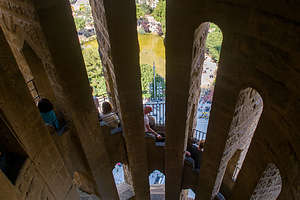 Climbing up the Nativity TowerIn contrast to the Gothic style, Gaudí’s design requires no supporting side walls, so he had the freedom to incorporate large stained glass windows to let in natural light. The stained glass windows are absolutely breathtaking. The sunlight filtering through them creates a magical and effect. Morning light shines most heavenly through the blues, greens, and other cool colors of the windows on one side of the church, while evening light performs its magic flowing through the reds, oranges, and other warm tones on the other.
Climbing up the Nativity TowerIn contrast to the Gothic style, Gaudí’s design requires no supporting side walls, so he had the freedom to incorporate large stained glass windows to let in natural light. The stained glass windows are absolutely breathtaking. The sunlight filtering through them creates a magical and effect. Morning light shines most heavenly through the blues, greens, and other cool colors of the windows on one side of the church, while evening light performs its magic flowing through the reds, oranges, and other warm tones on the other.
Bell Towers:
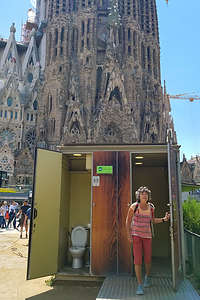 Lolo finishing her tour of the Sagrada FamiliaAs I mentioned, you can purchase tickets to climb up the towers in either the Nativity or Passion facades. We chose the Nativity Facade, because that was the only facade completed before Gaudi’s death. It involved climbing up 504 steps (no railings), which coiled round and round the tightly closed walls, like a snail. Looking down could be a bit scary for those uncomfortable with heights.
Lolo finishing her tour of the Sagrada FamiliaAs I mentioned, you can purchase tickets to climb up the towers in either the Nativity or Passion facades. We chose the Nativity Facade, because that was the only facade completed before Gaudi’s death. It involved climbing up 504 steps (no railings), which coiled round and round the tightly closed walls, like a snail. Looking down could be a bit scary for those uncomfortable with heights.
Along the way, we had views out the small windows of the sculptures on the rest of the Nativity facade. From the top there was an excellent view of eastern Barcelona and the mountains.
Wrap-Up
After 15 miles of walking and three tours of Gaudi’s works, I think we had accomplished what we had set out to do - immersing ourselves in the full Gaudi experience. It was an exhausting but very satisfying day. Time for a glass of wine and a toast to Antoni Gaudi, a truly unconventional and inspirational artist.
Speaking of unconventional, Herb's favorite photo of the Sagrada Familia is me exiting a porta potty, with a toilet in the foreground. Immature or genius? Who is to say?
Description
While I will not attempt to do an in-depth description of all Barcelona has to offer -- there are numerous guidebooks to do just that -- the following are some interesting sites that we enjoyed:
Las Ramblas pedestrian mall - one hour stroll from Playa de Catalunya to the La Rambla del Mar on the waterfront
- Broad pedestrian boulevard with souvenir hawkers, street artists, mimes, living statues, cafes, and shops
- More charming in the morning - grab breakfast at a market cafe
- Along the way:
- Fountain of Canaletes - ornate black and gold lamp post with a fountain at its base. Legend says that a drink from it ensures you will return to Barcelona one day
- Wavy tile work - represents the stream that once flowed here
- Look up to see the city’s characteristic shallow balconies with floor to ceiling windows
- Chairs fixed to the sidewalk at jaunty angles
- Betlem Church - 17th century Baroque church with sloping roofline, ball-topped pinnacles, corkscrew columns
- Rambla of Flowers - flower stands
- La Boqueria Market
- Plaça de la Boqueria - here you will see the Joan Miro mosaic in red, white, yellow, and blue
- Plaça Reial - dotted with palm trees and surrounded by yellow buildings with white trim this placa has old-fashioned taverns as well as modern bars with patio seating
- Palau Guell - apartment building designed by Antoni Gaudi. This was the first of his Modernista buildings, and you can see his emerging nonlinear style in the arches and doorways
- Christopher Columbus monument
- Rambla del Mar - wavy wooden walkway along the waterfront
Barri Gotic (Historic Gothic Quarter) walk - 1.5 hour self-guided tour from Placa de Catalunya to Placa del Rei
- Stroll the narrow Medieval lanes of Barcelona’s enchanting old quarter
- Relics of ancient Rome, 14th century Gothic churches, cobblestone lanes lined with shops, bars, and restaurants
- Along the way:
- Avinguda del Portal de l’Angel - once a major city gate. The angel statue atop the gate was said to keep Barcelonans safe from plagues and bid voyagers a safe journey
- Church of Santa Ana - 12th century Catalan Gothic church
- Els Quatre Gats - circa 1900 bohemian artist hangout, where Picasso had his first one-man show
- Playa Nova - flanked by two Roman towers that once guarded the entrance ate of the ancient Roman city of Barcino
- Barcelona Cathedral - 14th century Flamboyant-style (donation entrance 7 euros)
- Sardana dances, patriotic dance in which Barcelonans link hands and dance in a circle - on Sunday at 11:15 and many Saturdays at 18:00
- Casa del Ardiaca - old mansion that now functions as the city archives
- Carved mail slot (right of door) carved by a 19th century Modernista architect
- From the courtyard, climb to the balcony for views of the cathedral steeple and gargoyles
- Jewish quarter (El Call) - walk along the narrow passages and alleys where 4,000 Jews were forced to live
- Ruins of Roman Temple of Augustus - site where Romans founded the town of Barcino in 12 BC
- Placa del Rei - reminders of Barcelona’s medieval Golden Age
Barceloneta
- Traditional fishing neighborhood with gritty charm and good seafood restaurants
- Gorgeous man-made beach several miles long
- Stroll 4.5 km promenade - from La Estrella Herida to Peix
- La Estrella Herida - Contemporary 33-ft. beach sculpture of 4 stacked leaning steel cubes with windows, by Rebecca Horn.
- Peix (Fish) - giant copper-like Peix (Fish) sculpture by Frank Gehry glitters in the sunlight
La Sagrada Familia - Antoni Gaudi’s grand masterpiece
- Located in Eixample residential neighborhood, 1.5 miles north of Placa de Catalunya
- Hours: Mon - Sat 9:00 am - 8:00 pm; Sun 10:30 am - 8:00 pm)
- Timed-entry tickets - buy in advance: http://www.sagradafamilia.org/en/
- Gaudi labored on the Sagrada Familia for 43 years, from 1883 until his death in 1926. Work continued after his death and the church is expected to be finished in 2026 (a century after his death)
- Exterior
- Currently there are eight 330-foot spires topped with crosses. When completed there will be 18 - 12 representing the apostles, (over the three entrances), 4 taller ones representing the evangelists, an even higher one designated for the Virgin Mary, and the final 18th one, which will be the highest one in the middle, representing Jesus Christ
- The three facades - Nativity, Passion, and Glory, will chronicle Christ’s life from Birth, to crucifixion, to resurrection. Only the Nativity Facade was completed during Gaudi’s lifetime. The Passion Facade was completed in 2006, and the Glory Facade is still under construction
- Interior
- Floor plan is that of a Latin cross, 300 feet long and 200 feet wide - large enough to ultimately accommodate 8,000 worshippers
- The roof is held up by 56 tree-like columns, complete with branches and leaves, creating the effect of a forest canopy
- Sunlight filtering through stained glass windows creates a hypnotic, magical effect of a dappled rainforest canopy. Morning light shines in through blues, greens, and other cool colors, while evening light flows in reds, oranges and other warm tones.
Park Guell - Gaudi’s most ambitious project after Sagrada Familia
- 30 minute walk from Sagrada Familia
- Fanciful and playful space - two Hansel and Gretel gatehouses, dragon guarding a whimsical staircase, wavy benches, and a panoramic view terrace supported by a forest of columns
- Located 2 miles (uphill) to the northwest of Sagrada Familia
- Much of the park is free, except for the Monumental Zone where all the iconic Gaudi features are
- Zona Monumental (open daily 8:00 am to 8:30 pm)
- 400 visitors allowed in each hour
- Timed entry tickets - buy in advance (€ 10)
https://parkguell.barcelona/en/planning-your-visit/prices-and-times
L’Eixample - heart of Barcelona’s Modernista architectural movement
- Located north of the Old City
- Modernista - Free-flowing organic style that lasted from 1888 to 1906. It is characterized by wave-like curves, asymmetry, brightly colored glass and tile, and vegetal and other organic motifs
- Block of Discord - two of Gaudi’s colorful Modernista facades on Passeig de Gracia near the Metro stop)
- Casa Batllo - designed by Gaudi at his hallucinatory best
- Wave-shaped window frames and balconies, mushroom-shaped fireplace, and roof topped with a fanciful dragon-inspired roof
- Open daily from 9:00 am to 9:00 pm (but currently under renovation)
- Timed entry tickets - buy in advance
(€25)https://www.casabatllo.es/venta-entradas/ - La Pedrera (Casa Mila) - one of Gaudi’s trademark works and an icon of Modernisme
- Half hour walk from Park Guell
- Purist Gaudi interior in Barcelona
- One of the most notable elements of the building is the roof, crowned with skylights, staircase exits, fans, and chimneys.
- Open daily from 9:00 am - 8:30 pm
- Timed-entry ticket - buy in advance http://www.lapedrera.com/es/prepara-la-visita/tarifas
Montjuic - Large hill overlooking the city with Romanesque art, a fort, beautiful gardens, and art galleries and museums
- Fundacio Joan Miro (closed Mondays) - Barcelona’s best-looking gallery, set among gardens overlooking the city
- Tues - Sat 10:00 - 8:00, Sun 10:00 - 3:00
- Tickets: €13 https://www.fmirobcn.org/en/visit-us/opening-hours-and-prices/
- Montjuic Castle - at the top with great views of the city
- Dating from the late 17th century, for most of its dark history it has been used as a political prison and killing ground
- Tickets - €5
Picasso Museum - (closed Mondays)
- Set in five contiguous medieval stone mansions
- The collection, which includes more than 3500 of his works, concentrates on his formative years (from age 14 to 23) in Barcelona (pre-1904)
- Tues - Sun 9:00 am - 7:00 pm
- 12 € for timed-entry ticket (buy ahead of time on the museum website)
Parc de la Ciutadella (Citadel Park) - located in La Ribera section of the city (across the street from Motel One)
- Site of the 1888 Barcelona Universal Exposition, Spain's first International World's Fair
- Barcelona’s largest park - its 70-acre grounds include a small lake with rental rowboats, an ornamental fountain (which Antoni Gaudi helped design), the city zoo, a greenhouse, a winter garden, and plenty of green areas to sit and relax
- 1 of 20
- next ›
Barcelona location map in "high definition"
Javascript is required to view this map.
